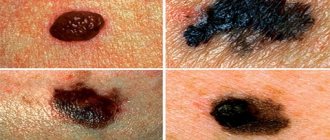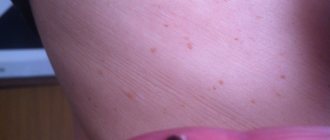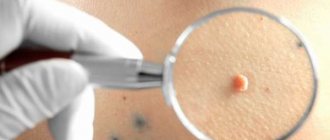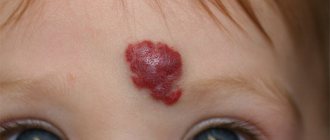Many people have noticed a phenomenon on their skin called a white halo around a mole. Some do not pay any attention to it, while others, on the contrary, begin to worry and suspect something is wrong. Let's figure out what kind of white spot this is, why it appears, and what you need to do if you find it on your body.
Reasons for the appearance of a halo around a mole
Pigmented areas on the skin are formed due to a local increase in the production of melanin, which is a protective segment against ultraviolet rays. It is nevi that are the first to react to a failure in the synthesis of this pigment.
There may be several reasons for the appearance of a white rim around a mole:
- Hereditary factor. Many moles with characteristic features are often passed on from parents to children. Genetic predisposition can be blamed for the fact that the appearance of a light spot, including a common nevus, becomes a distinctive family trait.
- The influence of ultraviolet radiation. Prolonged exposure to direct sunlight or tanning lamps can lead to decreased melanin production. A halo around a mole indicates a burn and serious damage to the skin.
- Changes in hormonal levels. At different periods of life, when a person experiences changes in hormone levels, the marks may disappear completely. This applies to adolescence, pregnancy and menopause, and taking hormonal contraceptives. The process begins with the formation of a white outline, which over time covers the entire nevus.
- Effect of radiation. Ionizing radiation negatively affects the human body. Even a small dose of radiation is enough to transform a mole into a malignant tumor.
- Injury. The spot around the nevus appears after mechanical impact on the skin - impact, friction, squeezing. This occurs due to the outflow of blood from the vessels located in the area of the damaged areas.
Whatever the reason for the whitened rim, you cannot leave a mole without observation.
Symptoms of nevus malignancy
Dangerous symptoms occurring with the formation are considered:
- a sharp change in the color of the halo around the mole to black, red, blue, brown or white. A distinctive feature of a white rim with a benign formation is the gradual appearance of color, and a malignant one - a sudden appearance;
- change in the shape of the nevus, the edges blur, acquiring an uneven contour;
- the appearance of spots of various colors on the tumor: black, burgundy or purple;
- the mole begins to grow and becomes asymmetrical;
- itching appears, the tumor begins to itch;
- nevus peeling;
- the appearance of an inflammatory frame;
- papillomas and warts with elements of necrosis may appear near the mole;
- burning and tingling nevus;
- cracks appear that can bleed and hurt;
- a change in the color of the nevus, possibly complete blackening or the appearance of a black dot on the surface.
If you detect at least one sign, visit a doctor. Do not postpone your visit for a long time. By identifying melanoma in time, complications can be avoided.
Types of nevi with a halo
If the area around the mole turns white, then there is a possibility that one of the following types of marks will form:
- Sutton's nevus is a brown mole with a rim of skin devoid of pigment. The spots have an irregular shape and merge with other moles. Sutton's nevi most often appear during puberty and do not require medical intervention.
- Nevus of Setton - pigment spots with a ring of white skin no more than 1 cm. In rare cases, the mole has a spotted surface on which long dark hairs grow. Setton's nevus can disappear on its own for no apparent reason, or it can remain with a person for the rest of his life.
- Vitiligo is a pigmentation disorder manifested by the appearance of white spots of varying sizes on the skin. As vitiligo develops, they grow and merge with each other. A person with this pathology does not experience discomfort; he is just not recommended to take prolonged sunbathing.
You might think that a light-colored spot on the body is not dangerous and only has an unaesthetic appearance. In fact, melanoma may be hidden under a benign formation. This malignant tumor tends to hide its appearance for a long time and very suddenly begins to grow and invade healthy tissue.
What symptoms should you see a doctor for?
The reason to check the condition of a mole with a white dot in the center should be:
- change in size: sudden growth or reduction;
- the appearance of purulent, bloody, bloody discharge from the head;
- increased body temperature;
- the appearance of itching;
- pain in and around the nevus;
- skin redness;
- the appearance of microcracks on the surface.
An obligatory reason for examination by a doctor is an injury to the formation.
The affected area must first be treated at home to stop the bleeding, if necessary, apply a bandage and cover with a bandage. Such measures will prevent infection. After the examination, the specialist will prescribe the necessary treatment: treatment with antiseptics and ointments. Deep injury requires a more detailed examination, dermatoscopy. If necessary, the nevus will be removed.
Self-medication is prohibited. It can lead to suppuration of the wound and the development of an inflammatory process.
Dangerous signs of halo zone pigmentation
If nevi with bleached areas of skin around them cause discomfort, then there is a high probability of developing a pathological process.
This is indicated by the following symptoms:
- growth and change in shape;
- uneven edges;
- nodules and tubercles on the surface;
- peeling and cracks;
- inflammation and swelling;
- color change;
- painful sensations and itching.
The presence of one or more signs indicates the activation of the tumor. In the inflamed skin, a biochemical process occurs, which is provoked by metabolic metabolism. This transformation most often turns out to be the initial stage of the degeneration of a mole into a malignant tumor.
Is it possible to squeeze out a mole with a white spot in the center?
The formation of a white core in a mole is not always alarming. Many people make the mistake of trying to squeeze it out. With superficial damage, internal tissues can be injured. If the process spreads to the subcutaneous fat layer, an abscess may develop. The active growth of the purulent focus begins. Necrosis often forms in its center.
Complications will negatively affect the growth. The inflammatory process will begin.
There is pain and swelling of the nevus itself and the skin around the affected area. Such changes several times increase the risk of malignancy of an initially benign growth.
When squeezing out the formation, a person can introduce an infection inside. Inflammation that develops after the incident is another risk factor for malignancy. It cannot be ruled out that after squeezing the pimple will not appear again. The area of the rash may increase significantly.
Diagnosis of nevi with a rim
If a white spot appears around the circumference of a mole, dermatologists recommend not waiting for degeneration and removing it with a formation. But before this, it is necessary to carry out a diagnosis, which will make it possible to verify the benign nature of the nevus.
It includes:
- General inspection. Using a magnifying glass with polarized light, a specialist visually examines the condition of the skin at the sites of tumors.
- Dermatoscopy. A layer of gel is locally applied to the patient’s skin; it increases the transparency of the upper layers of the epidermis. A special device (dermatoscope) examines the relief and structure of the nevus.
Experienced doctors do not recommend collecting material for histological examination before removing a mole. After all, trauma to a malignant tumor leads to an acceleration of the spread of metastases. Even in cases where the nevus does not pose a threat, a skin biopsy can provoke its degeneration.
Diagnostic methods
The main methods used to make a diagnosis include the following:
- Histological analysis . The doctor uses special instruments to collect material from the affected area of the skin. The resulting material is then analyzed in the laboratory. The test determines the presence of cancer cells and determines whether the white halo is a sign of melanoma.
- Dermatoscopy . This is a non-invasive research technique. It is based on identifying specific signs of melanoma. For examination, a special device is used, through which the oncodermatologist assesses in detail the condition of the skin cells.
Mole removal
After receiving the results of the examination confirming the possibility of removing the nevus, the dermatologist will suggest one of the ways to do it:
- Electrocoagulation. The impact on the mole occurs with high-frequency current with high intensity. The electric field provokes the formation of a thermal effect. Due to this, the damaged skin is cauterized, which prevents bleeding.
- Cryodestruction is the removal of a mole using low temperatures. A cotton swab soaked in liquid nitrogen is applied to superficial nevi. Exposure time – 3 minutes. During this period, numbness and subsequent tissue death occurs. If the mole has grown deeper, a cryodestructor is used. Liquid nitrogen is injected into the lower layers of the epidermis with a special needle, which is connected to sensors. The design allows you to control the temperature and interrupt the procedure if necessary.
- Laser removal is layer-by-layer removal of a mole with a directed beam of a certain length. The duration of the procedure is no more than 15 minutes without pain. Point exposure eliminates damage to healthy tissue.
- Radio wave method. A device that creates high-frequency waves transmits an impulse to a radio knife. It, in turn, acts on the skin without contact with it. The waves penetrate deep into the epidermis, cutting off tissue from the healthy area.
- Surgical method. After administering local anesthesia, the surgeon disinfects the site of the nevus and excises it with a scalpel. The tissue located just below the surface of the skin must be removed. If the mole is large in size and has grown deeply into the epidermis, then sutures are required after surgical removal.
Electrocoagulation of nevus
Each method has its advantages and disadvantages. They should be studied and the most effective and safe should be chosen. But under no circumstances should you try to get rid of an unusual mark on the body using folk methods. After all, no one can guarantee that an unexamined mole is not dangerous. And homemade lotions and baths can accelerate the spread of metastases, if any.
A white or black dot appears on a mole. What to do?
How dangerous is a white dot on a mole ? A white spot on a mole does not cause problems if it is stable and their number does not change for a long period. For a correct diagnosis, it is better to contact a doctor, since usually such phenomena occur spontaneously, and it is quite difficult to independently identify the cause.
Alas, moles are not always beauty. It happens that they are a signal of the onset of the disease. In medicine, moles are called nevi; most often they form during fetal development.
Are black spots on a mole a cause for concern?
Black spots on moles are not that common, but they need to be kept under control. This is how papillomavirus can manifest itself. It may not bother a person, but if there is a desire and the character is benign, it can also be removed.
A white or black dot appears on a mole
Such a mole may not always be melanoma. Blackheads can be the result of injury (nails, comb, etc.). If a mole is scratched, it is not necessary to go straight to an oncologist and observe for a while; in general, they quickly and without consequences take on their previous appearance.
Black and white dots on a nevus, even if they do not bother their carrier, can turn out to be much more serious than they initially seem. To avoid possible consequences and surgical interventions, it is better to consult a doctor without delay.
ICD code – 10
The International Classification of Diseases is usually called by the abbreviation ICD. The modern classification is already its 10th revision. Doctors all over the world use it constantly to:
- Provide a medical document to the patient when it is necessary to conceal the diagnosis;
- Fill out medical certificates, make extracts, issue patient records at the hospital;
- Prepare statistical documents.
The international classification allows not only the exchange of information, but also the preservation of medical confidentiality.
Nevi, like other diseases, have their own ICD code. It depends on the type of education:
- D22 – melanoform;
- Q82.5 – congenital non-tumor;
- 178.1 – non-tumor.
A well-known statistical fact: an adult has at least 20 moles on his body. Almost 100% of Europeans have moles.
In young children they are almost invisible; as they grow, nevi begin to appear on different parts of the body, including mucous membranes. Pregnancy can also cause them to appear.
Source: https://kozhainfo.ru/borodavki/belaya-tochka-na-rodinke
Preventing the appearance of white spots
The main preventative measure to never encounter a cosmetic defect on the skin is the absence of prolonged contact with UV rays. You should not be in the open area in the summer heat, especially during the midday hours. It is better to plan outdoor trips before 11 o'clock in the afternoon and after 18 o'clock in the evening. If you still need to go outside, then before going out, exposed skin should be lubricated with a protective agent.
In addition, it is important to avoid mechanical damage to moles. To do this, you should stop wearing tight clothes and shoes. If there is a convex nevus on the body, it is better to remove it. This will prevent accidental tearing off of the formation and possible activation of the pathological process.
From medical experts you can hear that moles are a potential health threat. Indeed, the cute marks that people are born with are localized holes in the skin. They indicate the imperfection of the protective functions of the epidermis and, under certain circumstances, can become a gateway for the spread of malignant cells.
Prevention and treatment
If a person is not characterized by suspicious formations, he still needs to remember about preventive measures:
- do not stay in the sun for a long time from 10 a.m. to 4 p.m., use UV protection;
- avoid contact with carcinogens;
- watch your diet, do not consume foods that contribute to cancer;
- remove suspicious moles.
Moles are inherent to everyone, so there is no point in removing them for the purpose of prevention. But if you notice a change in the color, shape, or symmetry of age spots, then you should contact a dermatologist or oncologist. Itching, burning, and inflammation should alert you. Any metamorphosis of nevi is not normal. They talk about illness, injury, and in the worst case, melanoma.
What skin phenomena can this indicate?
A change in the color of the mole area indicates the presence of a number of diseases and disorders. The task of a dermatologist is to identify the causes of the disease and comprehensive treatment of the patient. Common diseases are Vitiligo and Setton's nevus.
Vitiligo is a disorder of skin pigmentation that affects men and women in equal proportions. The mechanisms of development of pathology are unknown to science. It is known that the disease is not transmitted by contact. The formation of the disease may indicate a number of dysfunctions in the body, namely:
- Malfunctions in genes. People with brown/brown eyes have a high predisposition.
- Immune system disorders. The antibodies produced attack your own cells. Over time, rheumatoid arthritis or lupus erythematosus develops.
- Pathology of the endocrine gland. Diseases directly affect the functioning of the ovaries, pituitary gland and adrenal structures.
- Skin disorders after burns. The production of melanin provokes disruptions in the pigmentation of the skin.
- Decreased liver performance, which leads to stagnation of bile. As a result, the symptoms of vitiligo worsen.
- Complications due to medication.
- The result of the activity of chemical elements.
Setton's nevus is a dermal disorder that has single and multiple manifestations. The disease occurs in 1% of the population. However, treatment should not be neglected. The disease causes complications and indicates a number of dysfunctions in the body:
- the course of leukopathy;
- formation of autoimmune pathologies;
- specific skin reaction to solar activity;
- the presence of cytotoxic antibodies in the bloodstream. The mechanism of nevus depigmentation is the breakdown of melanocytes due to the activity of immune cells.
A dangerous consequence of the above-mentioned pathological processes is damage to the stain when scratching. Microbes and toxins enter the cracks, provoking an inflammatory process. Over time, intoxication of the patient’s entire body develops. In such cases, hospitalization and complex therapy of the patient is required. Explain to children that moles should not be scratched.
The method of treating white spots with surgery is carried out when the nevus has transformed into melanoma. Effective and safe options are:
- Application of laser. The approach eliminates the risk of additional disorders. The equipment simply does not come into contact with blood during surgery.
- Thermal impact. In this format, connective tissues suffer thermal damage. The operation is harmful for the child.
- Removal of pathological structures using radio waves. The mechanism is based on the evaporation of affected cells.
- Surgical intervention using nitrogen compounds. Low temperature conditions destroy the tissue structures of the nevus. Pathology should be removed gradually.
- Scalpel incision. A significant disadvantage of the operation is the formation of a scar. During the wound healing period, treatment with antiseptic substances will be required. In practice, a bandage, lotions and powders are used. If pus comes out, drainage is done. The goal of manipulation is to prevent infection.
Causes
Medicine cannot yet accurately answer the question of why halonevus appears, but it can identify conditions that contribute to its occurrence:
- People who suffer from vitiligo (a focal disorder of pigmentation) themselves, or who have close blood relatives with this disease, are more susceptible to the formation of halonevus.
- Presence of autoimmune diseases. This theory is supported by the discovery of antibodies to cells - melanocytes, which the body perceived as foreign bodies.
- Some researchers believe that Setton's nevus forms as a hypersensitive reaction to excessive ultraviolet radiation.
When moles become a source of problems
A mole may suddenly begin to manifest itself as a problem:
- The greatest danger is posed by congenital large nevi (more than 1 centimeter), especially those that are inherited;
- Moles that appear suddenly, dark spots that appear after fifty;
- When a flat spot becomes slightly raised, it may soften and break off in small sections. The skin around it turns red and swells.
To prevent moles from causing health problems, you need to follow some tips:
- Try to be in the sun for a short time and at certain morning and evening hours, while solar radiation is not so aggressive. From 11:00 to 15:00 it is better not to appear in the sun at all, especially if you have sensitive skin;
- If the area of skin has already turned white around the formation, you can cover it with light-colored clothing made from natural fabrics;
- Avoid mechanical injuries to moles.
With the advent of such education, we have to be more careful and attentive to our health.
What is the danger
Setton's nevus is a benign formation that is not prone to degeneration into melanoma. But there are some recommendations regarding such moles.
- Since a white rim of skin often appears with the formation of melanoma, you should definitely visit a doctor and make sure that the formation with a white rim is a halonevus.
- Multiple accumulations of Setton's nevi cause concern, as they can accompany the development of malignant processes within the body.
- Moles located in places subject to constant trauma or exposure to sunlight must be removed. This is the only case when the threat is posed by the nevus itself, which can degenerate with systematic irritation.
The greatest danger from the appearance of Sutton's nevi is in older people, when the immune system can fail in childhood. It is worth noting that in children the disappearance of nevi occurs much faster than in adults.
Dermatoscopy will show whether the formation is malignant
Skin oncology from papilloma to cancer
The appearance of nevi on the surface of a person’s skin indicates the presence of the human papillomavirus in his body and a disruption of the immune system.
Despite the fact that most structures are benign, under certain conditions, such as mechanical damage or the action of chemical factors, it is possible for them to transform into cancerous tumors. At the same time, the HPV infection present in the body ensures the process of rapid cell division, and the action of the highly oncogenic virus contributes to the recoding of the genetic information of cells.
This in total leads to a rapid spread of the area of localization of the pathology; a timely examination with the subsequent elimination of the neoplasm or its therapy can be used to avoid aggravation of the situation after the appearance of a white spot around the mole.











